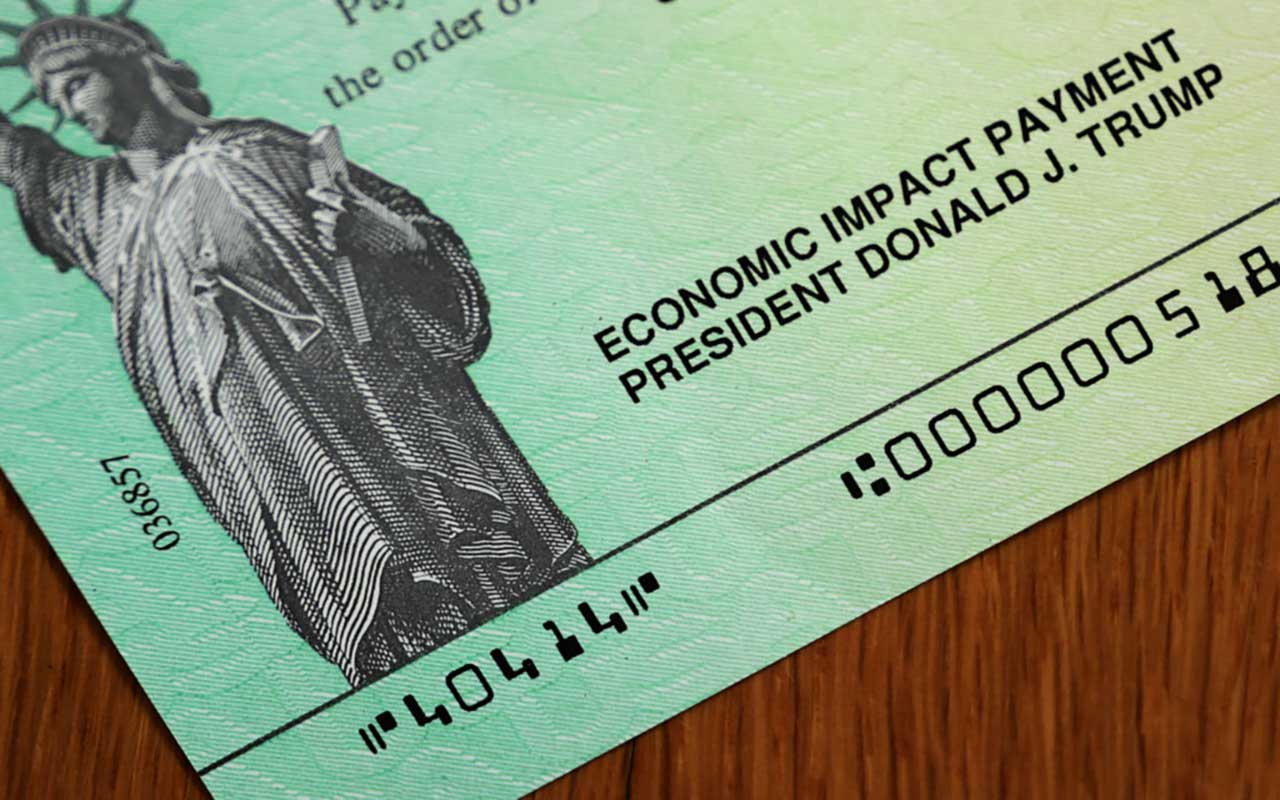Where's My Paper Stimulus Check? Some People May Have to Wait Until September
The IRS is reportedly sending out 5 million paper checks per week. At that pace, some checks might not arrive for months.


If your stimulus payment isn't deposited directly into your bank account, the IRS will send you a paper check in the mail. They've already started sending out paper checks, so you could get your check at any time now. However, the IRS can only send out a certain number of checks at a time—estimated to be about 5 million per week. That means that it's going to take a while for them to crank out a paper check for the tens of millions of Americans who are scheduled to get one in their mailbox.
Expected Mailing Schedule for Paper Stimulus Checks
The IRS's plan is to first get paper stimulus checks to the people who need them the most. As a result, the lower your income, the sooner you'll get your money. That also means that people with higher incomes will get their check later—if they get one at all. (For taxpayers without children, stimulus check amounts are reduced to zero for single taxpayers with adjusted gross income above $99,000, head-of-household filers with AGI above $136,500, and joint filers with AGI above $198,000.)
Here's the estimated timetable for mailing paper stimulus checks:

Sign up for Kiplinger’s Free E-Newsletters
Profit and prosper with the best of expert advice on investing, taxes, retirement, personal finance and more - straight to your e-mail.
Profit and prosper with the best of expert advice - straight to your e-mail.
Estimated IRS Schedule For Mailing Paper Checks
| Taxpayer Income | Date Check Mailed |
|---|---|
| $0 to $10,000 | April 24 |
| $10,001 to $20,000 | May 1 |
| $20,001 to $30,000 | May 8 |
| $30,001 to $40,000 | May 15 |
| $40,001 to $50,000 | May 22 |
| $50,001 to $60,000 | May 29 |
| $60,001 to $70,000 | June 5 |
| $70,001 to $80,000 | June 12 |
| $80,001 to $90,000 | June 19 |
| $90,001 to $100,000 | June 26 |
| $100,001 to $110,000 | July 3 |
| $110,001 to $120,000 | July 10 |
| $120,001 to $130,000 | July 17 |
| $130,001 to $140,000 | July 24 |
| $140,001 to $150,000 | July 31 |
| $150,001 to $160,000 | August 7 |
| $160,001 to $170,000 | August 14 |
| $170,001 to $180,000 | August 21 |
| $180,001 to $190,000 | August 28 |
| $190,001 to $200,000 | September 4 |
| All Others | September 11 |
People Who Receive Social Security or Other Government Benefits
The IRS has already started mailing stimulus checks to people receiving Social Security or Railroad Retirement Board (RRB) benefits. Unless you filed a tax return for 2018 or 2019, the IRS will use information from the Social Security Administration (or RRB) to calculate your payment and automatically deliver a payment to you. These non-filers will receive their payment by direct deposit, debit card or paper check—whichever way they normally receive government benefits.
Similar rules apply to people receiving veterans' benefits or Supplemental Security Income (SSI); however, payments won't go out to these people until mid-May if they didn't file a 2018 or 2019 tax return.
Signing Up for Direct Deposit
You are already scheduled to get an electronic payment if you signed up for direct deposit of a refund on your 2018 or 2019 tax return. In most other cases, you're probably scheduled to get a paper check.
However, if you're currently slated to receive a paper check, you still might be able to sign up for direct deposit (which in most cases means you'll get your money much faster). If you filed a 2018 or 2019 federal income tax return but didn't sign up for direct deposit (or didn't get a refund), go to the IRS's "Get My Payment" portal and see if it isn't too late to provide your bank account information to get an electronic payment. However, you might be out of luck if you don't do this before noon on May 13. (For more information, see Where's My Stimulus Check? Use the IRS's "Get My Payment" Portal to Find Out.)
If you're not required to file a tax return, go to the IRS's "Non-Filers: Enter Payment Info Here" tool to supply the IRS with the information it needs to process your payment. You generally don't need to use the non-filers tool if you receive any of the government benefits listed above. (For more information, see How to Get a Stimulus Check if You Don't File a Tax Return.)
Get Kiplinger Today newsletter — free
Profit and prosper with the best of Kiplinger's advice on investing, taxes, retirement, personal finance and much more. Delivered daily. Enter your email in the box and click Sign Me Up.
Rocky Mengle was a Senior Tax Editor for Kiplinger from October 2018 to January 2023 with more than 20 years of experience covering federal and state tax developments. Before coming to Kiplinger, Rocky worked for Wolters Kluwer Tax & Accounting, and Kleinrock Publishing, where he provided breaking news and guidance for CPAs, tax attorneys, and other tax professionals. He has also been quoted as an expert by USA Today, Forbes, U.S. News & World Report, Reuters, Accounting Today, and other media outlets. Rocky holds a law degree from the University of Connecticut and a B.A. in History from Salisbury University.
-
 Should You Get Earthquake Insurance?
Should You Get Earthquake Insurance?Standard home insurance doesn’t cover earthquakes, but paying extra for earthquake insurance isn’t just for Californians.
By Rachael Green
-
 Stock Market Today: Dow Drops 699 Points After Powell Speech
Stock Market Today: Dow Drops 699 Points After Powell SpeechFed Chair Powell warned of a slowing economy and higher inflation but said the central bank isn't ready to cut rates just yet.
By Karee Venema
-
 Here’s How the Harvard Trump Tax Threat Could Impact You
Here’s How the Harvard Trump Tax Threat Could Impact YouTax Law Trump's latest showdown raises fundamental questions that could reach beyond nonprofit tax status.
By Kelley R. Taylor
-
 Which Generation Pays the Most Taxes in the US?
Which Generation Pays the Most Taxes in the US?Tax Burden Polls show that most people feel like taxes are unfair. But which age group bears the brunt of the tax burden in the United States?
By Kelley R. Taylor
-
 Tax Day 2025: Don’t Miss These Freebies, Food Deals and Discounts
Tax Day 2025: Don’t Miss These Freebies, Food Deals and DiscountsTax Day You can score some sweet deals on April 15 in some select restaurants like Burger King, Shake Shack, and more.
By Gabriella Cruz-Martínez
-
 Tax Time: Does Your Kid Influencer Owe Taxes?
Tax Time: Does Your Kid Influencer Owe Taxes?State Tax Some minors are making big money on social media. Here’s how to know if they need to file taxes.
By Gabriella Cruz-Martínez
-
 Ask the Editor: Readers' Tax Questions, April 11, 2025
Ask the Editor: Readers' Tax Questions, April 11, 2025Ask the Editor: Taxes, April 11, 2025 — Joy Taylor, The Kiplinger Tax Letter Editor, answers questions on Roth IRAs, RMDs and other retirement accounts.
By Joy Taylor
-
 Free IRS Tax Filing for 30 Million People: Will It Continue Under Trump?
Free IRS Tax Filing for 30 Million People: Will It Continue Under Trump?Tax Filing Direct File was piloted last year in 12 states and has since expanded to 25. But some wonder whether the program will last under the Trump administration.
By Gabriella Cruz-Martínez
-
 Did Florida’s Chance at $1,000 in Property Tax Rebates Vanish?
Did Florida’s Chance at $1,000 in Property Tax Rebates Vanish?State Taxes The Florida Legislature bypassed Gov. Ron DeSantis’ wish to cut property taxes and instead voted to lower the state’s sales tax.
By Gabriella Cruz-Martínez
-
 How Caregivers for Adults Can Save on Taxes in 2025
How Caregivers for Adults Can Save on Taxes in 2025Tax Breaks Caring for your parent or spouse can be stressful, but the IRS offers tax breaks for qualifying taxpayers. Here they are.
By Kate Schubel